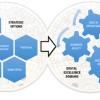Business Transformation Requires Transformational Leaders
Leadership and teaming skills are front and center in times of rapid change. Meet today’s constant disruption head on with expert guidance in leadership, business strategy, transformation, and innovation. Whether the disruption du jour is a digitally-driven upending of traditional business models, the pandemic-driven end to business as usual, or the change-driven challenge of staffing that meets your transformation plans — you’ll be prepared with cutting edge techniques and expert knowledge that enable strategic leadership.
Subscribe to Arthur D. Little's Culture & Leadership Newsletter
Insight
Today, when everybody wants to disrupt their own or somebody else’s business, and new technologies that let them do it seem to appear almost daily, people with the “capacity to lead” are critical, and nowhere more than in the exploitation of IT. Obvious though this is, recognizing, empowering, and sustaining good IT leaders has been a challenge. People who can think strategically about what, why, and how to deploy technology but have trouble delivering it — and the reverse — fall short as IT leaders. Both skills are needed, and this edition of Cutter Business Technology Journal covers them in great depth.
Seven Ways to Gamify Social Collaboration
Social collaboration is not about technology. It’s about connecting people, and it’s changing the way business is being conducted. Similarly, gamification is not about games. It’s about motivating the personal and professional behaviors that drive business value. Together, social collaboration and gamification help companies reap great benefits — among them, the ability to deepen customer relationships, drive operational efficiencies, and optimize their workforce.
If you are spending US $50,000+ per month on public cloud, you have likely reached the penultimate rung of cloud torment — a journey from the Plains of Forecasting to the Gates of Commitment — and certainly you want to pass through the Undercroft of Budgetary Responsibility as unscathed as possible. Even those organizations that have been in and around the cloud for some time will need to go deeper to understand how to address challenges to their cloud buyer strategy. What’s around the corner for some CIOs is already a reality for those organizations in the throes of digital revitalization.
The new generation is looking for life-work balance as well as inspiring leaders who will fire them up and motivate them. In the new workplace, company values actually need to mean something. People need to see their leaders living and breathing these values every day.
Using Roadmaps Strategically
Roadmaps have two key functions in strategy planning. The first is to outline planned architectural changes that will deliver the required strategies; the second is to outline alternative ways to achieve the same results.
Managing the Cloud Dilemma: To Outsource or Not to Outsource
Our analysis in this Executive Update builds upon the challenges and risks we outlined in a previous Update, which showed how managers in regulated firms face a quandary: whether to play it safe and lock out cloud-based innovations and correspondingly lock themselves out of related innovations or to negotiate a rocky course, balancing the risks associated with these technologies and regulatory expectations. This Update provides a detailed assessment to help management understand when to strategically engage with cloud technologies and when to avoid them, thereby helping executives balance the need to innovate with the need to manage compliance risk. Our assessment, based on research and data collection conducted from 2014-2016, allows managers to evaluate the criticality of impacted services to maintaining compliance along with managers’ ability to understand and control transparency and supervision over cloud arrangements.
Thinking in terms of digital business capabilities helps focus on things that need to be done to achieve expected business results.
The Gig Economy
I have been a member of the “gig” economy for the last 20 years — I just didn’t know it.


















